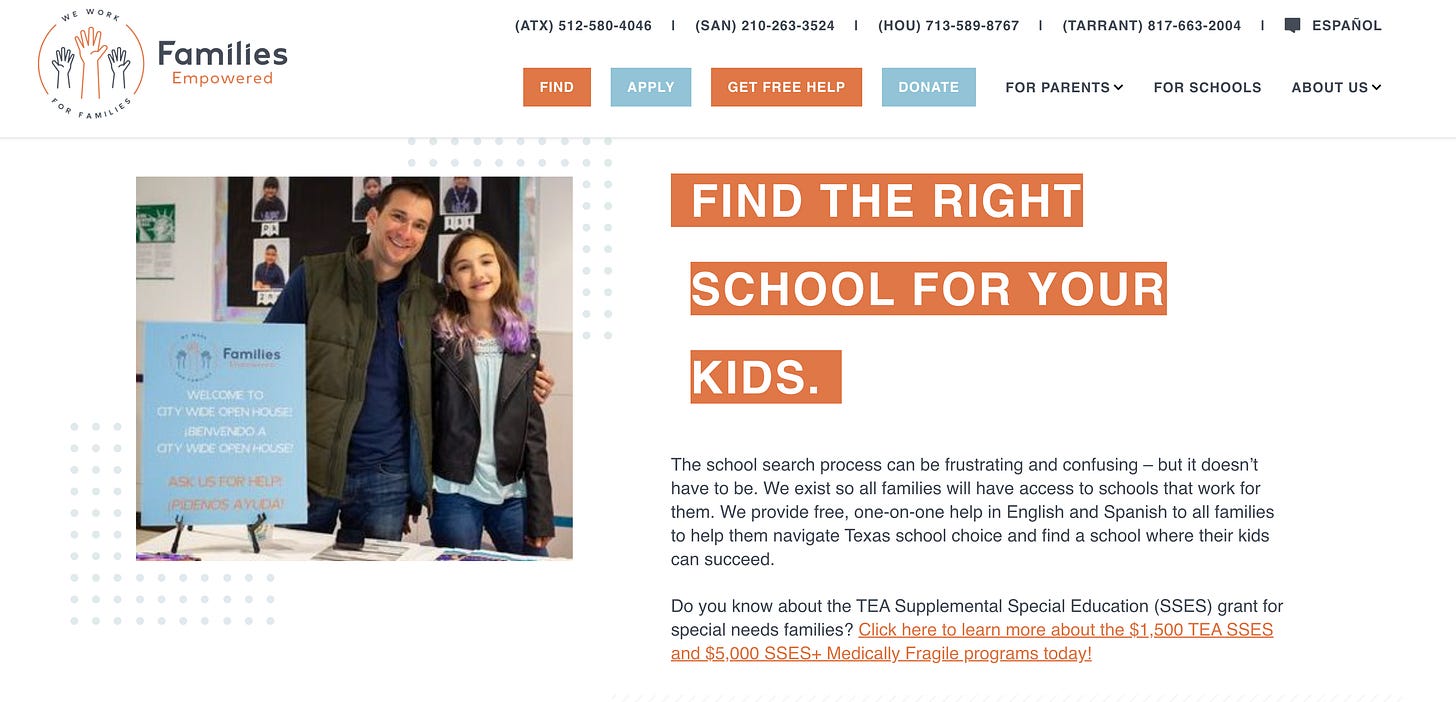The Parent Challenge in School Choice
In theory, there is no difference between theory and practice. In practice, there is.
tl;dr – To fulfill its promise and potential, an ESA program needs to pay local education advisors (“edvisors”) to provide trustworthy, neutral support to parents as they investigate options and make decisions about their children’s education. To do this, edvisors must work only for families, be paid by the state, and not have an incentive to pull kids out of public district and charter schools if that is what families determine is the best choice for them.
The underlying premise of ESA programs is that parents are the best decision-makers when it comes to the education of their children. Is this true?
Raising children puts parents in the laboratory of human development, principal investigators in a continuous series of experiments with daily successes and failures. Parents constantly test hypotheses about their kids, generating thousands of experiments to determine what modifies behavior and builds character, and what doesn’t. And kids are never a “one and done”; as they grow the hypotheses and experiments and results change as well. Every child is different, and having committed adults responsible for each kid is the secret sauce for turning each kid into a responsible adult capable of making and keeping commitments.
And from a pure data standpoint, no centralized system could ever compete with this kind of continuous engagement. It’s like human intelligence vs. ChatGPT: modern AI models may have massive datasets, but a 6 month old child has processed far more data than any AI system has ever done, or likely ever will. Parents not only know more about their kids than anyone else does, they know more than anyone else can.
But managing a kid’s education is more than just knowing about that individual child; it’s also understanding the education sector and its options and opportunities that can help that child flourish.
As our society has grown larger, the complexity of the sector and diversity of choices has become overwhelming for the average parent, indeed for virtually all parents. So we turn to people with specialized knowledge - dare I say, experts - to help find the optimal solution.
Most parents are capable of developing sufficient mastery of the education sector to manage their kids’ education, but that takes time, the precious commodity that is always in short supply in the modern family. A common rule of thumb is that mastery requires 5,000 hours of effort. At 8 hours per week, it would take you more than 12 years to achieve that level of mastery, meaning you’d figure it out right about the time your kindergartener is graduating from high school - not very helpful in practice. So expecting every parent to achieve that level of mastery, that breadth of general knowledge, is impractical.
This tension between specific knowledge about a child and general knowledge about education must be resolved by every education system. Parents are experts about their kids, but they aren’t education experts, and education experts can talk about “children” but know almost nothing about any given child (save their own), and the kid an expert dismisses as an “outlier” could be yours.
One solution - the dominant approach for the past century in the US - is to leave education to the experts. Parents drop their kids off at school in the morning, pick them up in the afternoon, and in-between a group of experts guide their cognitive and moral development. Education administrators (and politicians) decide what to teach, when to teach it, and often how to teach, and monitor progress.
This all works fine in many circumstances, but at scale we know what happens to such systems: they become standardized, routinized, compliance-oriented, and unable to create personalized options for consumers.
In a big crowd, everyone is alone.
In response, a fake, dysfunctional equilibrium can result: teachers pretend to teach, students pretend to learn, and parents pretend they know what’s going on.
The movement to create school choice and ESAs is a response to this situation. Its goal is to move decision-making authority away from experts and toward parents. But there is a question that still lurks in the background, shouted loudly from the rooftops by ESA critics and spoken sotto voce by ESA advocates:
Are parents really up to the task of managing their kids’ education?
My answer is yes. Most parents can do this. In this regard, statists are wrong.
But my answer is also no. Most parent’s can’t do this without help. In this regard, libertarians are wrong.
Parents have a huge advantage over education experts. As I said above, no one understands kids like their parents. And no one loves a child like parents (and love is the key ingredient of the education secret sauce I mentioned above).
But I also believe it is unrealistic to expect parents in today’s world to figure out the best practical way to educate their children without the right kind of support.
To understand why, and how we might address this challenge, let’s consider some key characteristics of a decision about a child’s education :
It is a very high stakes decision. Choosing a school or education program for a child is immensely important, arguably the second-most important duty of parents (first is feeding their kids). Parents - regardless of income or social status - feel intense pressure to get this right, and the implications of getting it wrong are scary. Selecting a school is not like selecting a toothpaste.
It is a decision that is made infrequently if made well. For the most part, parents are not regular buyers of education services. They may choose a school with a K-8 program for their kindergartener; if it turns out to be a good choice, they won’t have to select another school for 8 years. Another reason to really make sure they’re making the right decision for their kids.
It is a complex decision given time constraints and deadlines. There is a lot to consider, and a lot to research, to select an education program like a school for your child. Is the school safe? What is the culture of the school? Do I like the principal and other leaders? Is there high turnover in the teaching ranks? Do they use a curriculum that reflects my family’s values? How much does it cost? How is the school governed? Should I even send my kids to school? Do I have to run for school board to effect change, or are the leaders of the school responsive to parent feedback? Where is the school located? Is it near my house, or place of work? What are its hours of operation, and how does that fit with my work schedule? Do they have the specialized programs I think my kid will need given their talents? And if I’m looking at multiple schools, I have to do this analysis for each of them, and many of these answers are not knowable without direct engagement with the school - you can’t learn some important items without physically going there. None of these questions individually are all that difficult to answer, but they all take a lot of time if you’re starting from scratch and having to do all the work yourself.
Each of these characteristics can create bias in parental decision making. High-stakes decisions make parents risk averse. Infrequent decisions put parents at a negotiating disadvantage vs. schools who are always in the game. Complex, compressed decisions lead to confusion and mistakes.
Sounds hopeless, right? There’s no way the average parent can figure all this out.
Well, before we just give up, consider that choosing a school is not the only decision of this type. In fact there are at least two other common decisions made by families that share these three characteristics: purchasing a home and planning for retirement.
Let’s focus on home buying. That decision definitely has the characteristics listed above: it’s high stakes (a house is often the largest asset owned by a family), it is made infrequently (home buyers tend to stay put for many years), and it’s complicated (it generally involves mortgages, mortgage brokers, insurance, inspections, title, earnest money, contracts, legal fees, and those are just for transaction itself, after actually looking at neighborhoods, touring houses, putting in offers, negotiating terms, and so on).
Sounds hopeless, right? There’s no way the average homebuyer can figure all this out.
But turns out that it’s manageable as long as buyers are working with a trusted intermediary: their realtor.
A realtor can be an advisor to the buyer, although they can also represent sellers. They get to know their clients, help sort through the best neighborhoods and best streets, keep an eye out for new homes coming on the market, arrange tours and go to open houses, look at previous transactions to assess market conditions and comps, advise buyers during the negotiation, and then once an offer is accepted they guide the buyers through the transaction process.
A good realtor is a critical resource to a buyer, but they are not the buyer. They are an agent, not a principal. At the end of the day, the family signs the offer, the mortgage, and the purchase contract, and the family lives in the home.
And they help make the residential real estate market work - in reality. The market for single-family homes is not like a farmer’s market, with buyers transacting directly with sellers. Instead it is a mediated market, mediated by realtors. If realtors weren’t around, buying a home would be much harder, there would be many fewer transactions, and the market would be much a less efficient. Buyers would become more risk averse, more easily taken advantage of, and prone to mistakes and misunderstandings that can impede efficient markets.
Trusted intermediaries are not limited to the residential real estate world; they’re also baked into the retirement planning and financial services business. Financial planning is also high stakes, infrequently done if done well, and complicated. So, in the same way, an entire profession has arisen to facilitate these transactions: the financial planner.
My view, informed by more than a decade of work at a non-profit I co-founded and chair, Families Empowered1, is that parents are (with rare exceptions) the best people to control education decisions for their children, but they need the same kind of facilitating resource in education that realtors and financial planners provide. Let’s call these people education advisors, or edvisors for short.
How would edvisors work in an ESA program? Here are three essential elements that need to be addressed:
Payment. Brokers - whether real estate, financial services, or education - almost always get paid by the seller. Buyers generally don’t understand the value of trusted intermediaries, so they will not hire them if they have to pay them. With rare exception, the people who get the money have to pay, and in the case of an ESA the group with the money is the state. Therefore, the state needs to pay edvisors, not parents.
Neutrality. Edvisors need to be neutral. They cannot push a particular kind of school or program, and they should not make recommendations to parents. What they should do is help make the process time efficient. Time is the critical resource that needs to be optimized, and a good edvisor - like a good realtor or financial planner - can provide a curated list of options based on what the client wants.
When designing an education advisory function for an ESA program, it is critical that edvisors NOT be paid ONLY if parents choose an ESA. After weighing the pros and cons of an ESA vs. district or charter options, the best choice could well be a traditional school, not an ESA-funded private option. But if edvisors are only paid if a family accepts an ESA, the system will create a perverse financial incentive that will ultimately undermine the trust essential to facilitating the market. Edvisors must be trusted intermediaries. (Note that this neutrality is also important to the supply side - to public district and charter schools - as well as to families. Sellers want a fair and unbiased marketplace for selling their goods.)
Real, local human beings. There is a myth that technology can solve the parent support problem. Just give parents a good website or app with a school finder, and voila! Success and satisfaction.
Both realtor associations and financial management firms make massive investments in technology to aid their clients. But at the end of the day, technology is not enough. People need trusted advisors, and they generally don’t trust technology (for good reason), and they definitely don’t trust technology alone to guide them in making purchases that are high-stakes, infrequent, and complex. Do you know any buyer of an owner-occupied home who made their purchase online alone, based only on what they read on a website or app?
Anyone? Bueller? Bueller?
The reality is that technology is necessary but not sufficient. People want to work with people they know and trust. But if you’re going to work with a person, you want someone who will get to know you, understands the local environment, someone you can trust. Running a big call center might be helpful but it is nowhere near enough. People need people from their community to help them navigate the education system.
Bottom line: edvisors need to be local folks with local knowledge.
Anyway, the message is clear: to fulfill its promise and potential, an ESA program needs to pay local edvisors to provide trustworthy, neutral support to parents as they make decisions about their children’s education.
And this is not just a theoretical need; states that have recently created or expanded ESAs have found out the hard way that they underinvested in parent support. Programs that seem simple to policymakers are, in practice, impenetrable to many parents. The gap created by this underinvestment has led to confusion, underutilization, and frustration, and some states are now working hard to backfill this function.
Texas should learn from the experience of these pioneering states and fund education advisory services that will provide local edvisors to families who are exploring ESAs for their kids’ education. Baking this capability into the program from the start is way better than trying to fix it after it becomes a problem.
Full disclosure: I have never made a penny from Families Empowered. In fact, I’m a major donor for over a decade. Just want to be clear about my own personal situation. I believe in the work of FE and care about the families we serve, but I have no personal financial interest in its operations.








